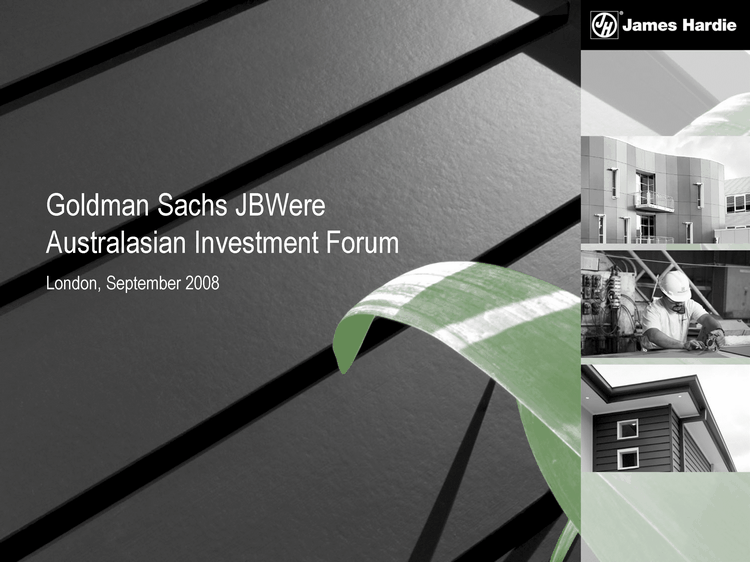


| Annual net sales US$1,469m million Total assets US$2,180m Operations in North America, Asia Pacific and Europe 2,700 employees Market cap US$1.8b S&P/ASX 100 company NYSE listing Note: Net sales and total assets are at 31 March 2008 A growth focused company James Hardie |

| Growth focused Sustainable competitive advantage Unique proprietary technology Strong financial performance, cash flows and balance sheet1 Track record of outperforming US housing market Investment attributes 1 Excluding asbestos related items 1 Excluding asbestos related items Focused on Fibre Cement |
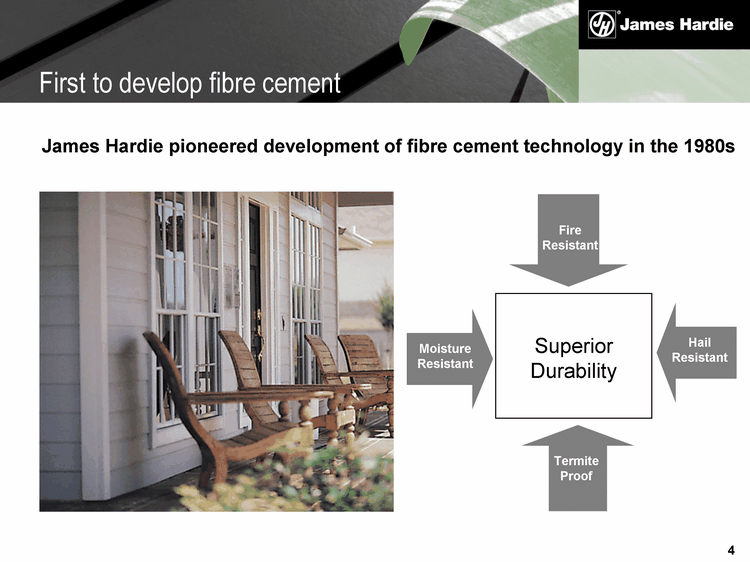
| James Hardie pioneered development of fibre cement technology in the 1980s Superior Durability Fire Resistant Termite Proof Fire Resistant Hail Resistant Moisture Resistant Termite Proof First to develop fibre cement |
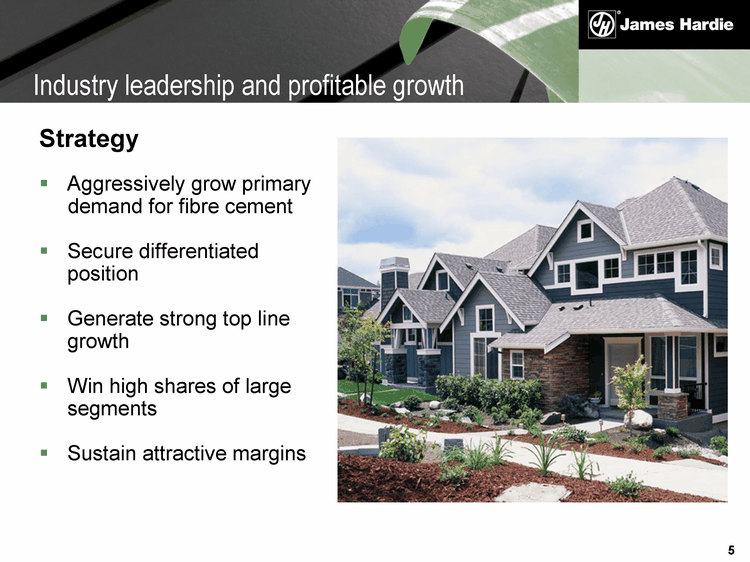
| Aggressively grow primary demand for fibre cement Secure differentiated position Generate strong top line growth Win high shares of large segments Sustain attractive margins Strategy Industry leadership and profitable growth |
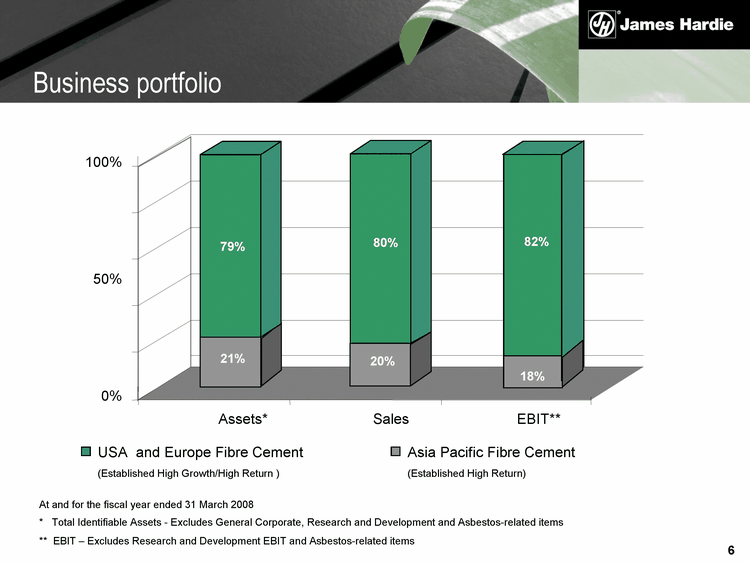
| At and for the fiscal year ended 31 March 2008 * Total Identifiable Assets - Excludes General Corporate, Research and Development and Asbestos-related items ** EBIT - Excludes Research and Development EBIT and Asbestos-related items Business portfolio USA and Europe Fibre Cement (Established High Growth/High Return ) Asia Pacific Fibre Cement (Established High Return) 0% 50% 100% Assets* Sales EBIT** 79% 80% 82% 21% 18% 20% |
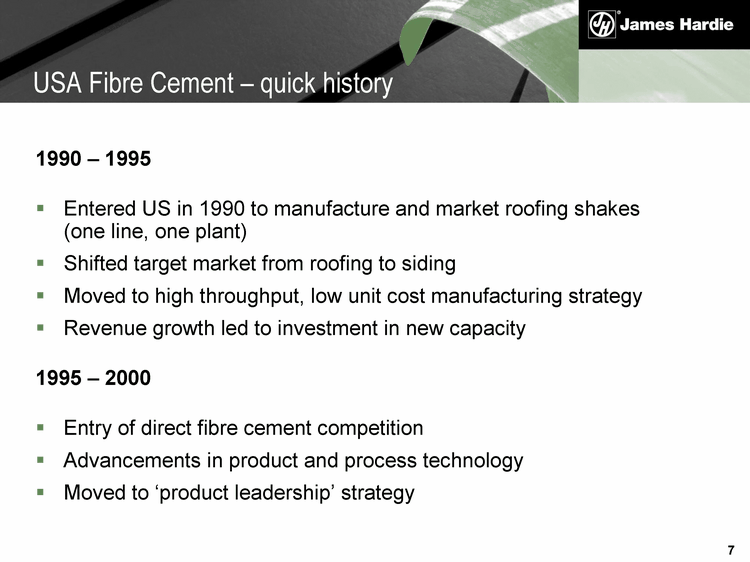
| 1990 - 1995 Entered US in 1990 to manufacture and market roofing shakes (one line, one plant) Shifted target market from roofing to siding Moved to high throughput, low unit cost manufacturing strategy Revenue growth led to investment in new capacity 1995 - 2000 Entry of direct fibre cement competition Advancements in product and process technology Moved to 'product leadership' strategy USA Fibre Cement - quick history |
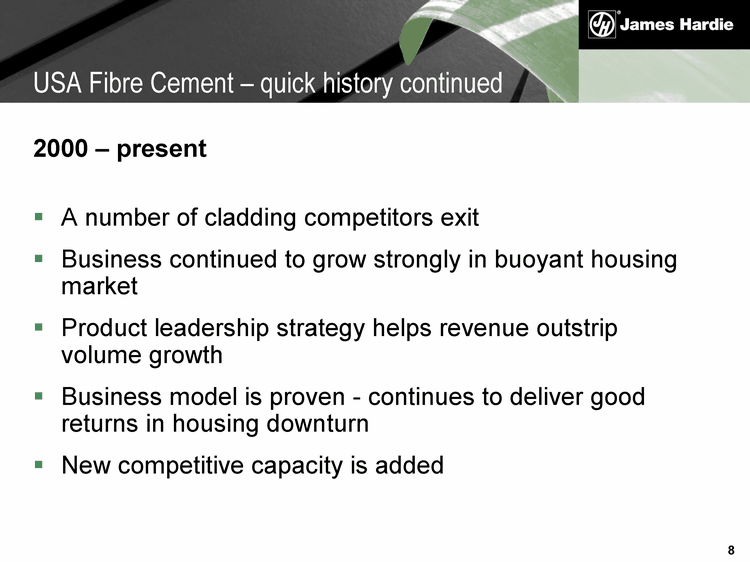
| 2000 - present A number of cladding competitors exit Business continued to grow strongly in buoyant housing market Product leadership strategy helps revenue outstrip volume growth Business model is proven - continues to deliver good returns in housing downturn New competitive capacity is added USA Fibre Cement - quick history continued |
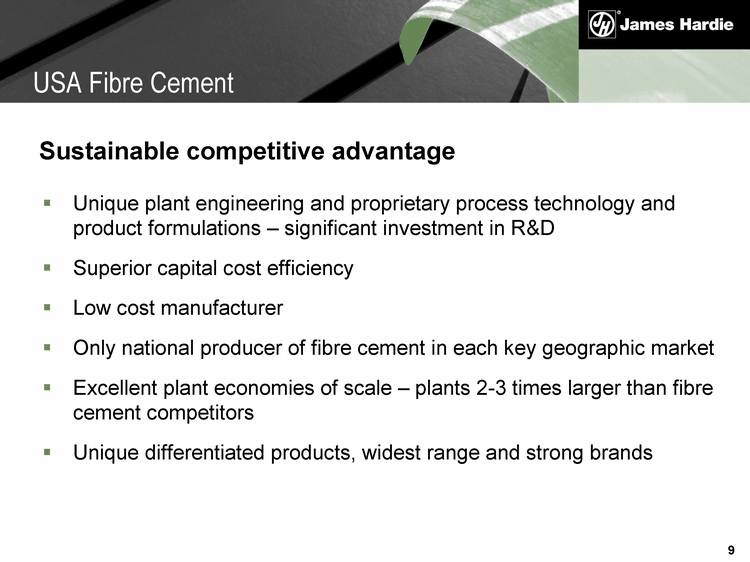
| Unique plant engineering and proprietary process technology and product formulations - significant investment in R&D Superior capital cost efficiency Low cost manufacturer Only national producer of fibre cement in each key geographic market Excellent plant economies of scale - plants 2-3 times larger than fibre cement competitors Unique differentiated products, widest range and strong brands Sustainable competitive advantage USA Fibre Cement |

| Exterior products Siding Soffit Fascia Trim Interior products 1/4 inch backerboard Hardiebacker 500(r) Total net sales compound annual growth rate of 17% (FY02 - FY08) USA Fibre Cement - revenue growth streams |
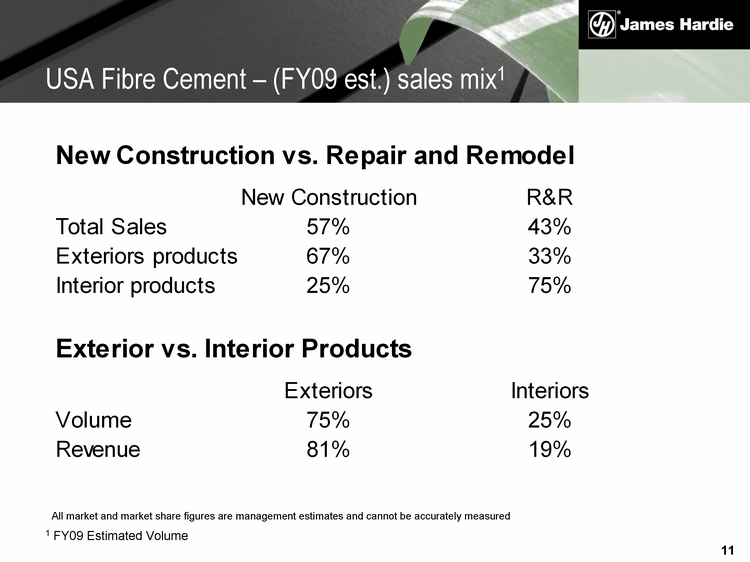
| USA Fibre Cement - (FY09 est.) sales mix1 1 FY09 Estimated Volume All market and market share figures are management estimates and cannot be accurately measured |
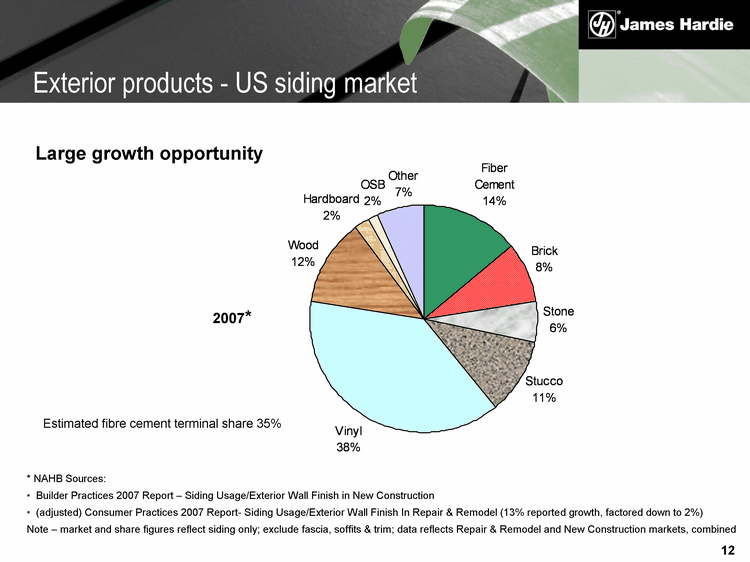
| Exterior products - US siding market Large growth opportunity 2007* * NAHB Sources: Builder Practices 2007 Report - Siding Usage/Exterior Wall Finish in New Construction (adjusted) Consumer Practices 2007 Report- Siding Usage/Exterior Wall Finish In Repair & Remodel (13% reported growth, factored down to 2%) Note - market and share figures reflect siding only; exclude fascia, soffits & trim; data reflects Repair & Remodel and New Construction markets, combined Estimated fibre cement terminal share 35% |
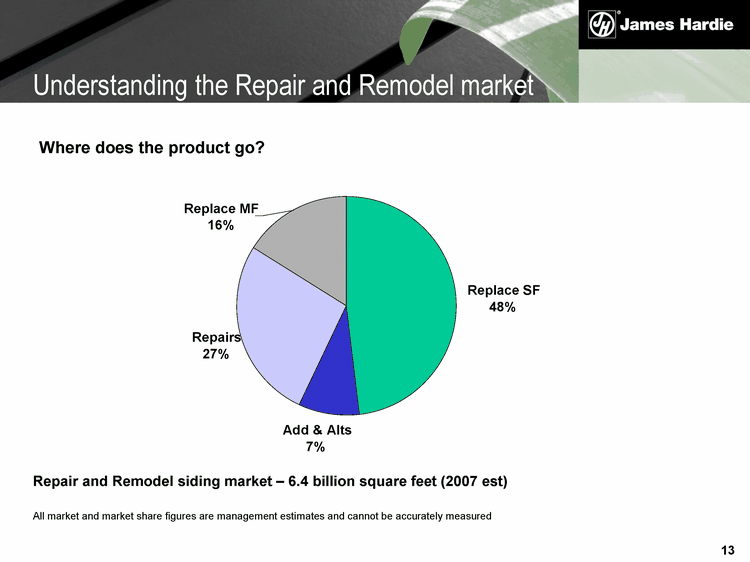
| Repair and Remodel siding market - 6.4 billion square feet (2007 est) Where does the product go? Understanding the Repair and Remodel market Replace SF 48% Add & Alts 7% Repairs 27% Replace MF 16% All market and market share figures are management estimates and cannot be accurately measured |
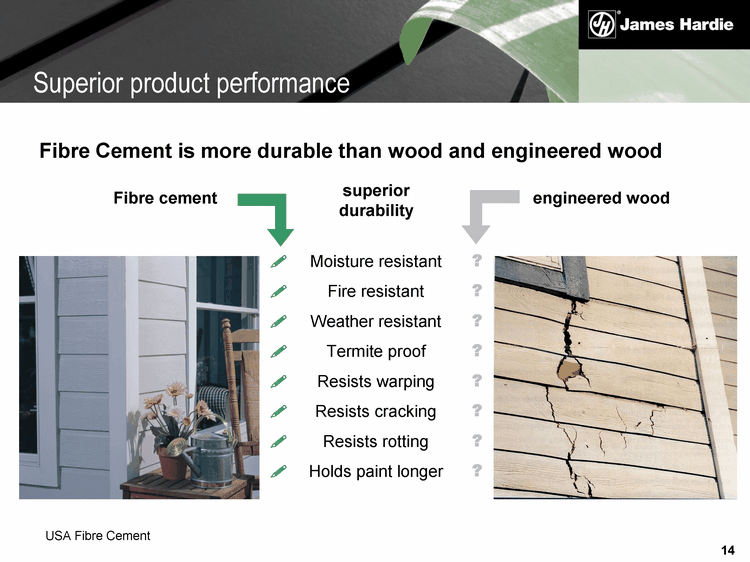
| Fibre Cement is more durable than wood and engineered wood Fibre cement superior durability Moisture resistant Fire resistant Weather resistant Termite proof Resists warping Resists cracking Resists rotting Holds paint longer ? ? ? ? ? ? ? ? ? ? ? ? ? ? ? ? engineered wood USA Fibre Cement Superior product performance |
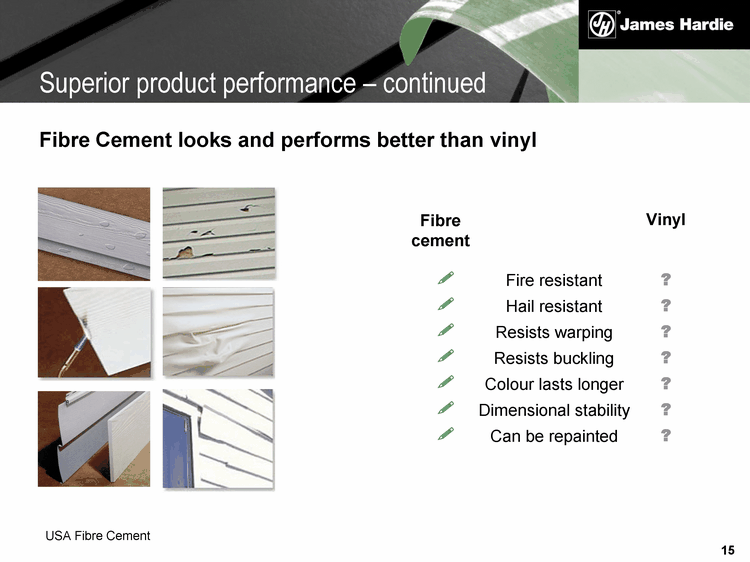
| Fibre Cement looks and performs better than vinyl Vinyl Fire resistant Hail resistant Resists warping Resists buckling Colour lasts longer Dimensional stability Can be repainted ? ? ? ? ? ? ? ? ? ? ? ? ? ? Fibre cement USA Fibre Cement Superior product performance - continued |
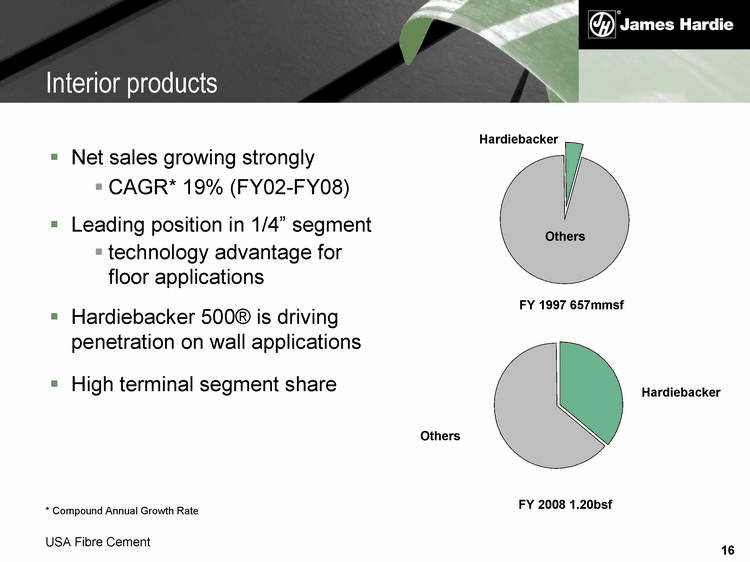
| Net sales growing strongly CAGR* 19% (FY02-FY08) Leading position in 1/4" segment technology advantage for floor applications Hardiebacker 500(r) is driving penetration on wall applications High terminal segment share * Compound Annual Growth Rate USA Fibre Cement Hardiebacker FY 1997 657mmsf FY 2008 1.20bsf Others Hardiebacker Others Interior products |
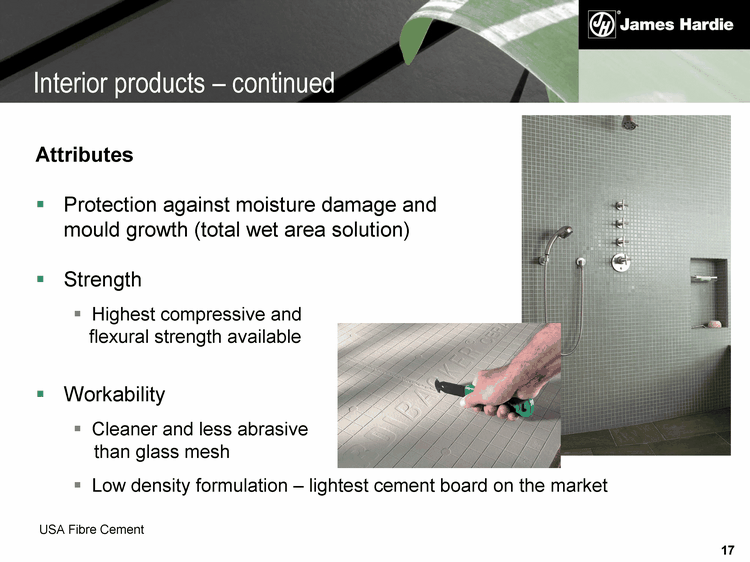
| Attributes Protection against moisture damage and mould growth (total wet area solution) Strength Highest compressive and flexural strength available Workability Cleaner and less abrasive than glass mesh Low density formulation - lightest cement board on the market USA Fibre Cement Interior products - continued |
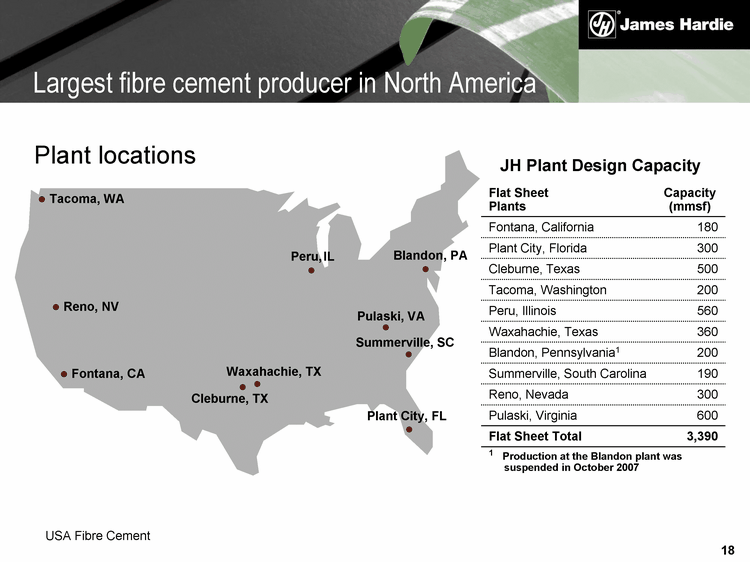
| Flat Sheet Plants Capacity (mmsf) Fontana, California 180 Plant City, Florida 300 Cleburne, Texas 500 Tacoma, Washington 200 Peru, Illinois 560 Waxahachie, Texas 360 Blandon, Pennsylvania1 200 Summerville, South Carolina 190 Reno, Nevada 300 Pulaski, Virginia 600 Flat Sheet Total 3,390 1 Production at the Blandon plant was suspended in October 2007 1 Production at the Blandon plant was suspended in October 2007 JH Plant Design Capacity Plant locations USA Fibre Cement Tacoma, WA Plant City, FL Waxahachie, TX Cleburne, TX Peru, IL Blandon, PA Summerville, SC Pulaski, VA Reno, NV Fontana, CA Largest fibre cement producer in North America |
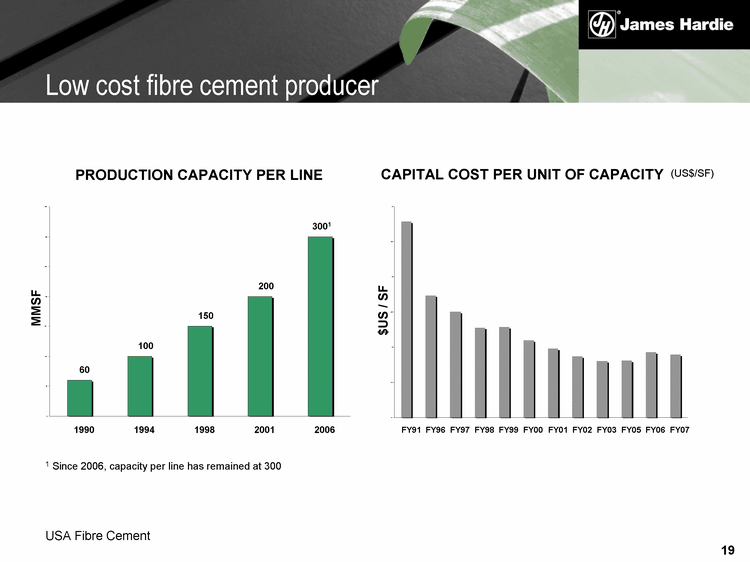
| USA Fibre Cement CAPITAL COST PER UNIT OF CAPACITY (US$/SF) 0.1 0.15 0.2 0.25 0.3 0.35 0.4 FY91 FY96 FY97 FY98 FY99 FY00 FY01 FY02 FY03 FY05 FY06 FY07 $US / SF PRODUCTION CAPACITY PER LINE 60 100 150 200 3001 0.1 50.1 100.1 150.1 200.1 250.1 300.1 350.1 1990 1994 1998 2001 2006 MMSF Low cost fibre cement producer 1 Since 2006, capacity per line has remained at 300 |
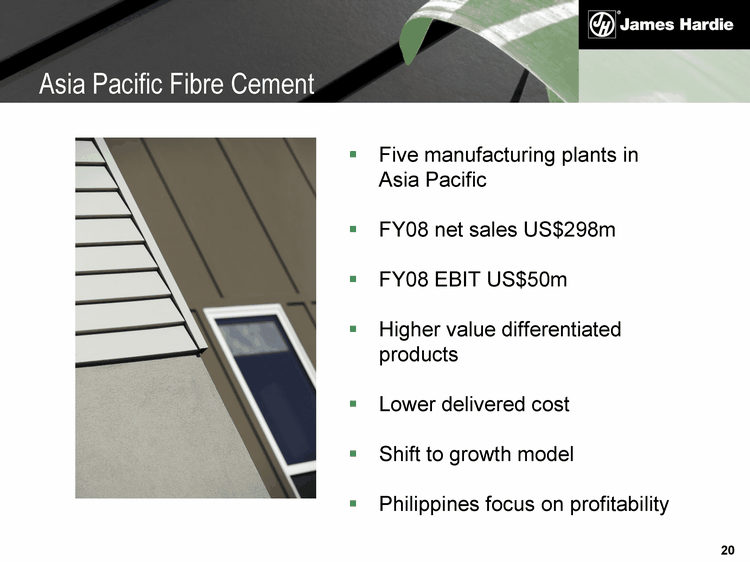
| Asia Pacific Fibre Cement Five manufacturing plants in Asia Pacific FY08 net sales US$298m FY08 EBIT US$50m Higher value differentiated products Lower delivered cost Shift to growth model Philippines focus on profitability |
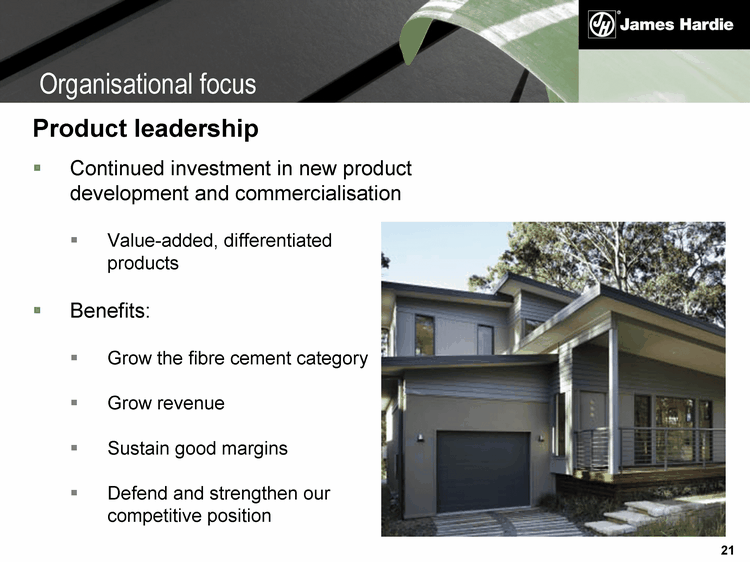
| Product leadership Continued investment in new product development and commercialisation Value-added, differentiated products Benefits: Grow the fibre cement category Grow revenue Sustain good margins Defend and strengthen our competitive position Organisational focus |
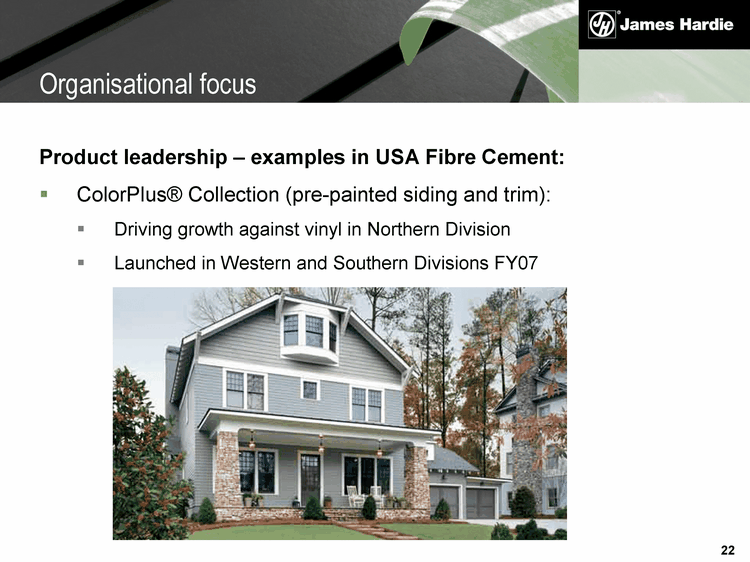
| Product leadership - examples in USA Fibre Cement: ColorPlus(r) Collection (pre-painted siding and trim): Driving growth against vinyl in Northern Division Launched in Western and Southern Divisions FY07 Organisational focus |

| Higher quality products with higher revenue stream Strategy designed to reduce 'on the wall' cost and close gap with vinyl siding Supply of pre-painted exterior products Reduce supply chain costs Installer education Channel increases revenue base and gains incremental volume End-user gets higher quality product at reduced cost USA Fibre Cement ColorPlus(r) Model |
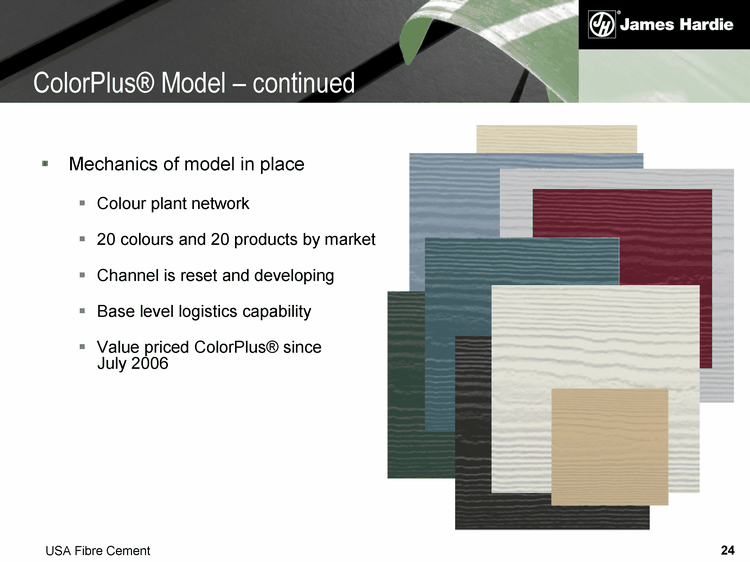
| Mechanics of model in place Colour plant network 20 colours and 20 products by market Channel is reset and developing Base level logistics capability Value priced ColorPlus(r) since July 2006 USA Fibre Cement ColorPlus(r) Model - continued |
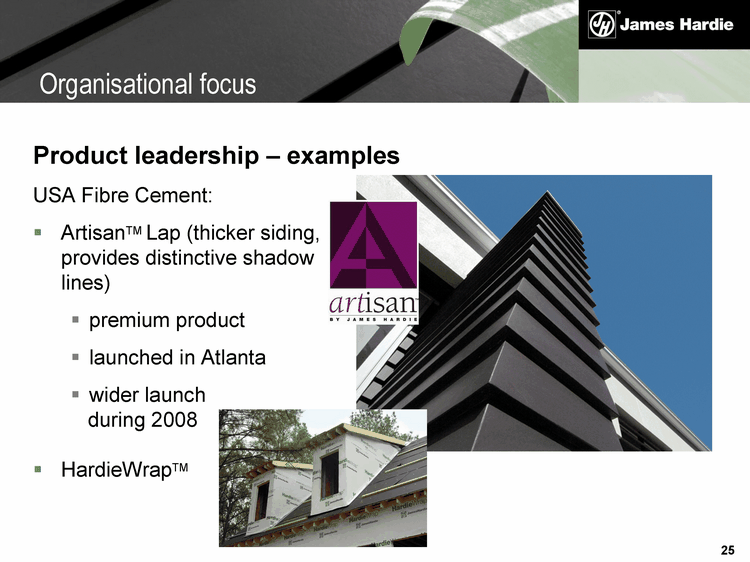
| Product leadership - examples USA Fibre Cement: ArtisanTM Lap (thicker siding, provides distinctive shadow lines) premium product launched in Atlanta wider launch during 2008 HardieWrapTM Organisational focus |
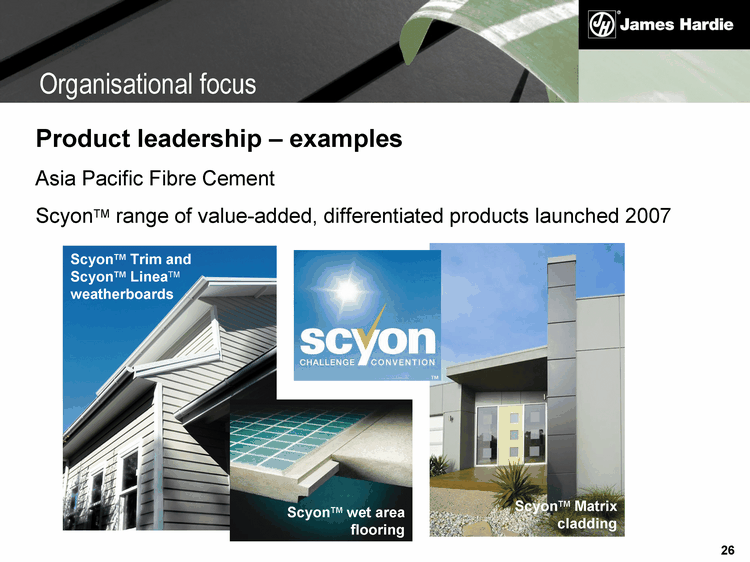
| Product leadership - examples Asia Pacific Fibre Cement ScyonTM range of value-added, differentiated products launched 2007 ScyonTM wet area flooring ScyonTM Trim and ScyonTM LineaTM weatherboards ScyonTM Matrix cladding Organisational focus |
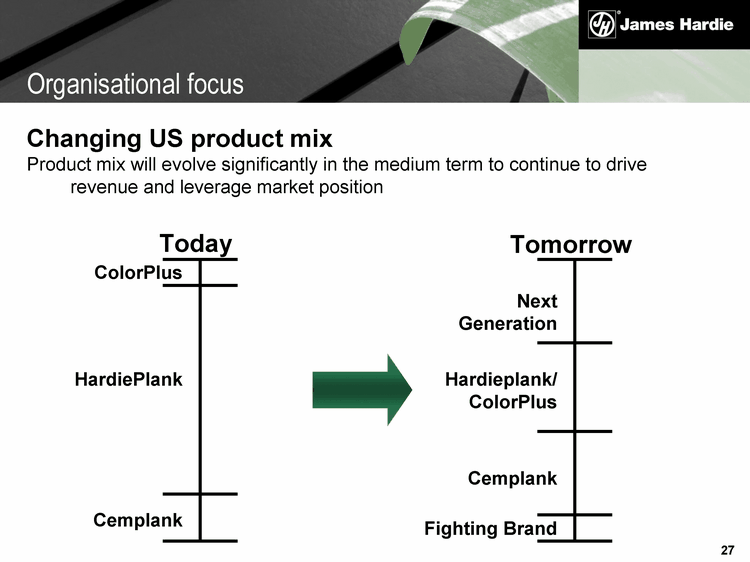
| Today Tomorrow HardiePlank ColorPlus Cemplank Next Generation Fighting Brand Cemplank Hardieplank/ ColorPlus Changing US product mix Product mix will evolve significantly in the medium term to continue to drive revenue and leverage market position Organisational focus |
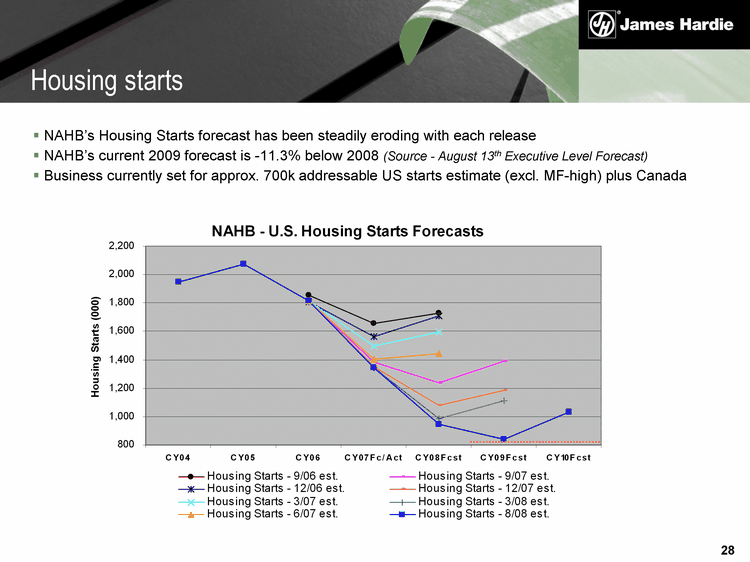
| NAHB's Housing Starts forecast has been steadily eroding with each release NAHB's current 2009 forecast is -11.3% below 2008 (Source - August 13th Executive Level Forecast) Business currently set for approx. 700k addressable US starts estimate (excl. MF-high) plus Canada Housing starts |
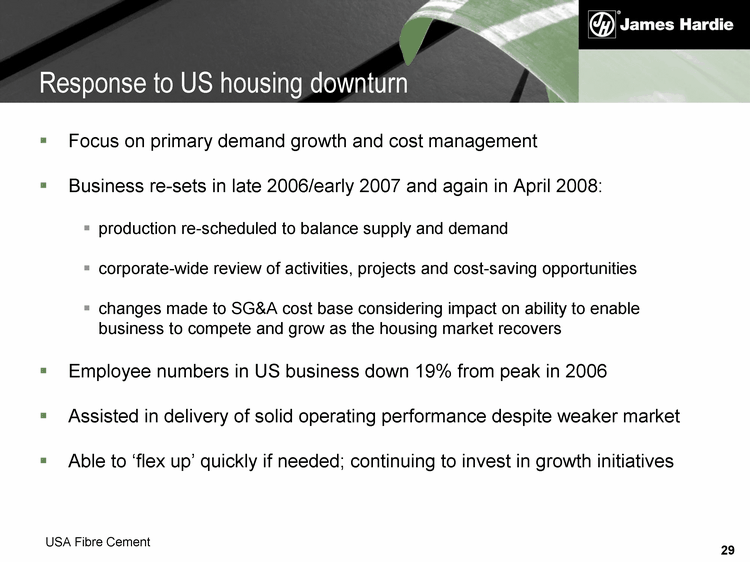
| Focus on primary demand growth and cost management Business re-sets in late 2006/early 2007 and again in April 2008: production re-scheduled to balance supply and demand corporate-wide review of activities, projects and cost-saving opportunities changes made to SG&A cost base considering impact on ability to enable business to compete and grow as the housing market recovers Employee numbers in US business down 19% from peak in 2006 Assisted in delivery of solid operating performance despite weaker market Able to 'flex up' quickly if needed; continuing to invest in growth initiatives USA Fibre Cement Response to US housing downturn |

| Top line growth 0 400 800 1,200 1,600 2,000 2,400 2,800 90 91 92 93 94 95 96 97 98 99 00 01 02 03 04 05 06 07 08 $0 $200 $400 $600 $800 $1,000 $1,200 Revenue (US$M) JH Volume JH Revenue Housing Starts Q1 09 JH Volume (mmsf), Starts (000s Units) Rolling 12 month average of seasonally adjusted estimate of housing starts by US Census Bureau. USA Fibre Cement |
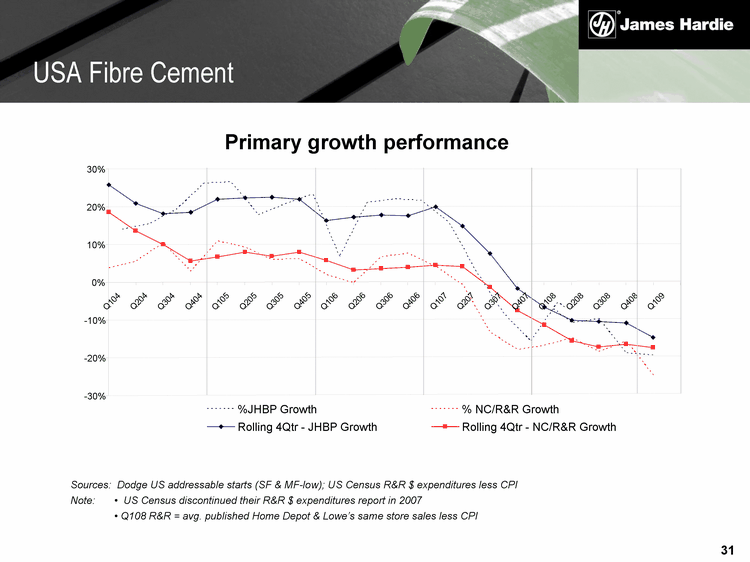
| Primary growth performance USA Fibre Cement Sources: Dodge US addressable starts (SF & MF-low); US Census R&R $ expenditures less CPI Note: • US Census discontinued their R&R $ expenditures report in 2007 • Q108 R&R = avg. published Home Depot & Lowe's same store sales less CPI - -30% - -20% - -10% 0% 10% 20% 30% Q104 Q204 Q304 Q404 Q105 Q205 Q305 Q405 Q106 Q206 Q306 Q406 Q107 Q207 Q307 Q407 Q108 Q208 Q308 Q408 Q109 %JHBP Growth % NC/R&R Growth Rolling 4Qtr - JHBP Growth Rolling 4Qtr - NC/R&R Growth |
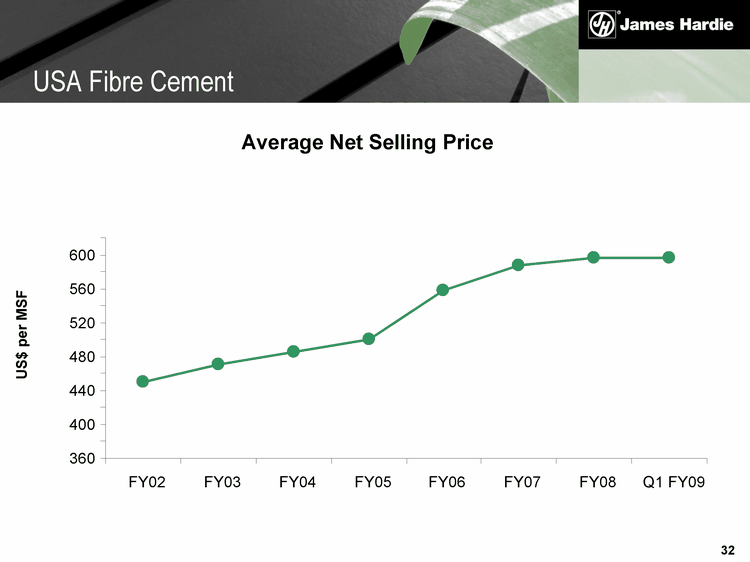
| Average Net Selling Price US$ per MSF 360 400 440 480 520 560 600 FY02 FY03 FY04 FY05 FY06 FY07 FY08 Q1 FY09 USA Fibre Cement |
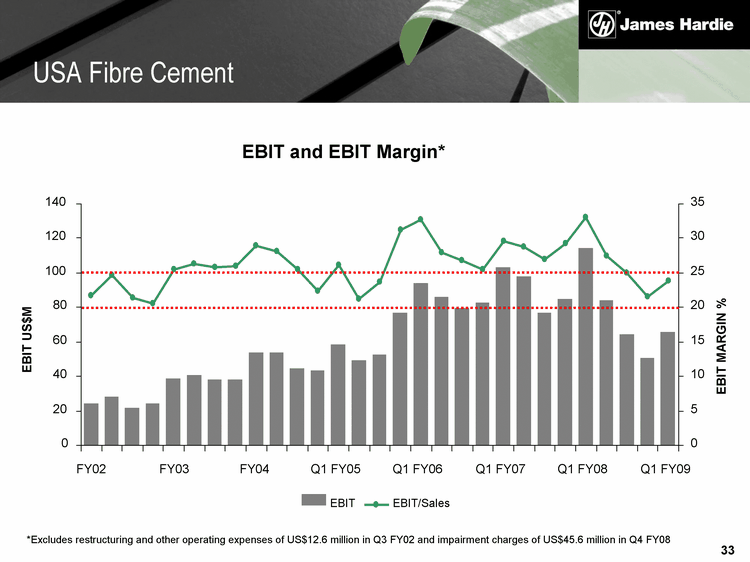
| *Excludes restructuring and other operating expenses of US$12.6 million in Q3 FY02 and impairment charges of US$45.6 million in Q4 FY08 EBIT and EBIT Margin* 0 20 40 60 80 100 120 140 FY02 FY03 FY04 Q1 FY05 Q1 FY06 Q1 FY07 Q1 FY08 Q1 FY09 EBIT US$M 0 5 10 15 20 25 30 35 EBIT MARGIN % EBIT EBIT/Sales USA Fibre Cement |
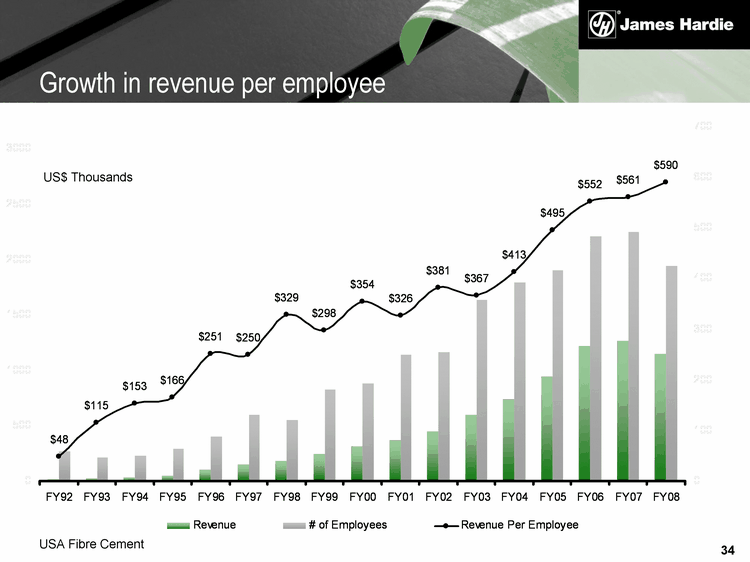
| Growth in revenue per employee US$ Thousands USA Fibre Cement |
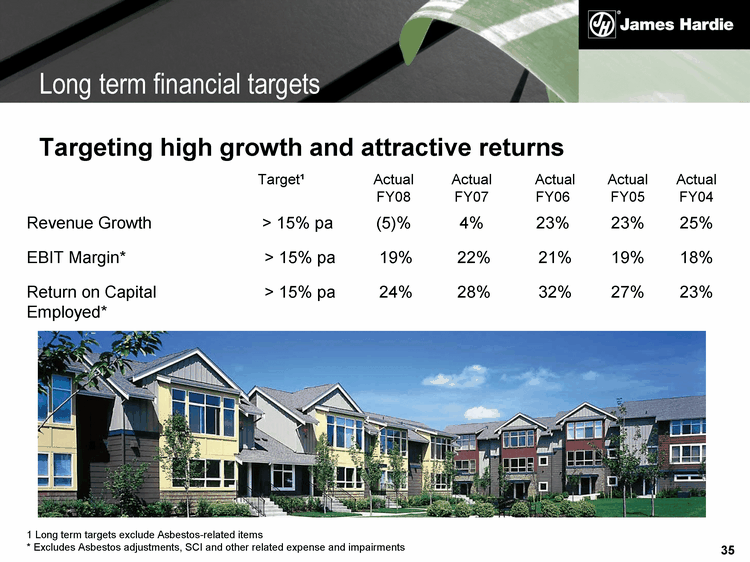
| Targeting high growth and attractive returns Target1 Actual FY08 Actual FY07 Actual FY06 Actual FY05 Actual FY04 Revenue Growth > 15% pa (5)% 4% 23% 23% 25% EBIT Margin* > 15% pa 19% 22% 21% 19% 18% Return on Capital Employed* > 15% pa 24% 28% 32% 27% 23% 1 Long term targets exclude Asbestos-related items * Excludes Asbestos adjustments, SCI and other related expense and impairments Long term financial targets |
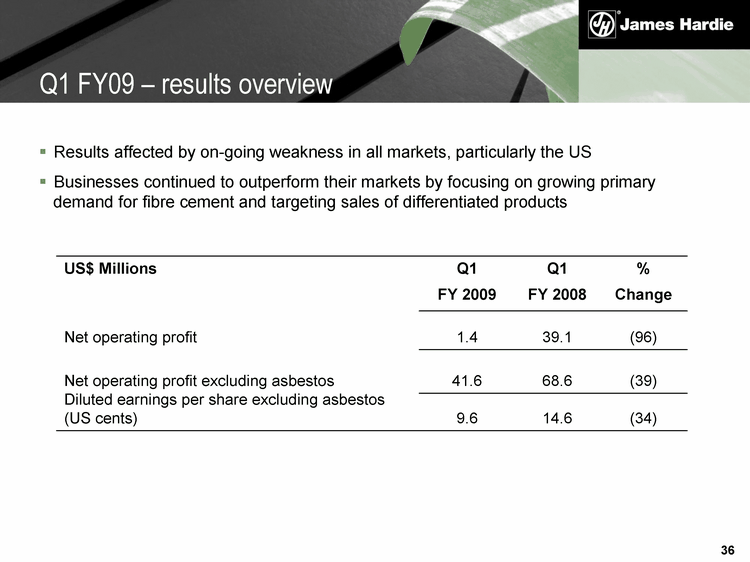
| US$ Millions Q1 Q1 % FY 2009 FY 2008 Change Net operating profit 1.4 39.1 (96) Net operating profit excluding asbestos 41.6 68.6 (39) Diluted earnings per share excluding asbestos (US cents) 9.6 14.6 (34) Results affected by on-going weakness in all markets, particularly the US Businesses continued to outperform their markets by focusing on growing primary demand for fibre cement and targeting sales of differentiated products Q1 FY09 - results overview |
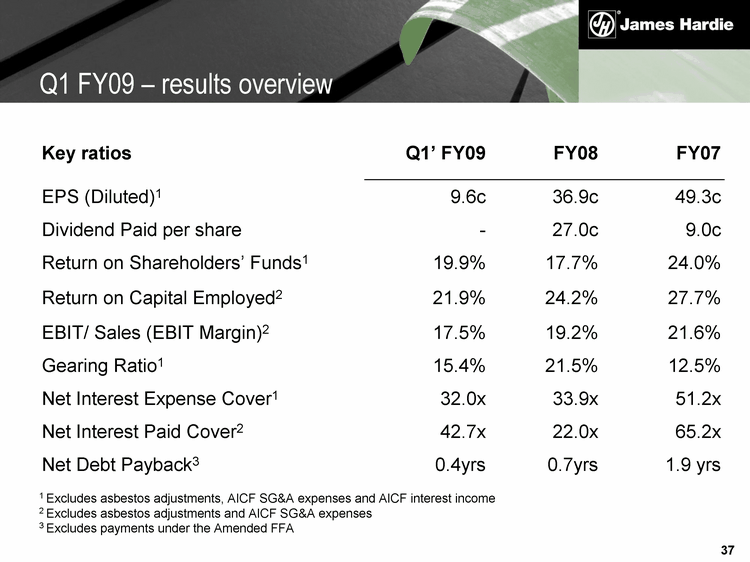
| Key ratios Q1' FY09 FY08 FY07 EPS (Diluted)1 9.6c 36.9c 49.3c Dividend Paid per share - 27.0c 9.0c Return on Shareholders' Funds1 19.9% 17.7% 24.0% Return on Capital Employed2 21.9% 24.2% 27.7% EBIT/ Sales (EBIT Margin)2 17.5% 19.2% 21.6% Gearing Ratio1 15.4% 21.5% 12.5% Net Interest Expense Cover1 32.0x 33.9x 51.2x Net Interest Paid Cover2 42.7x 22.0x 65.2x Net Debt Payback3 0.4yrs 0.7yrs 1.9 yrs 1 Excludes asbestos adjustments, AICF SG&A expenses and AICF interest income 2 Excludes asbestos adjustments and AICF SG&A expenses 3 Excludes payments under the Amended FFA Q1 FY09 - results overview |

| Company faces challenges that stem from legacy issues, including: Managing obligations under Amended Final Funding Agreement (approved by shareholders in February 2007): Asbestos compensation funding; Financial results affected by movements in exchange rate between A$ and US$ because asbestos liability is in A$ - company reports in US$; US$0.01 change in A$:US$ exchange rate = approximately US$8.0 million foreign exchange gain/loss on asbestos liability Australian Tax Office: Litigating amended assessment on RCI (subsidiary company) for FY 1999 2002 and 2004-2006 tax audits - ATO successful in obtaining court order for reinstatement of JHAF, and likely to issue amended assessment for approximately A$240m Corporate issues and challenges |
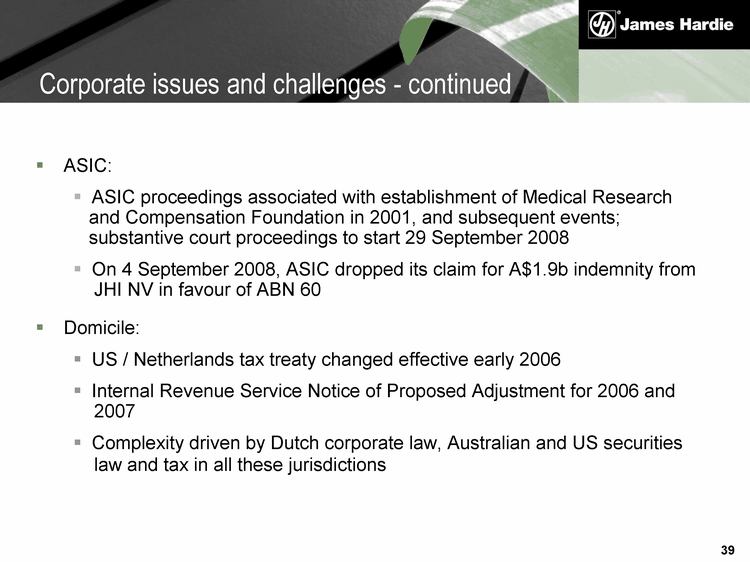
| ASIC: ASIC proceedings associated with establishment of Medical Research and Compensation Foundation in 2001, and subsequent events; substantive court proceedings to start 29 September 2008 On 4 September 2008, ASIC dropped its claim for A$1.9b indemnity from JHI NV in favour of ABN 60 Domicile: US / Netherlands tax treaty changed effective early 2006 Internal Revenue Service Notice of Proposed Adjustment for 2006 and 2007 Complexity driven by Dutch corporate law, Australian and US securities law and tax in all these jurisdictions Corporate issues and challenges - continued |
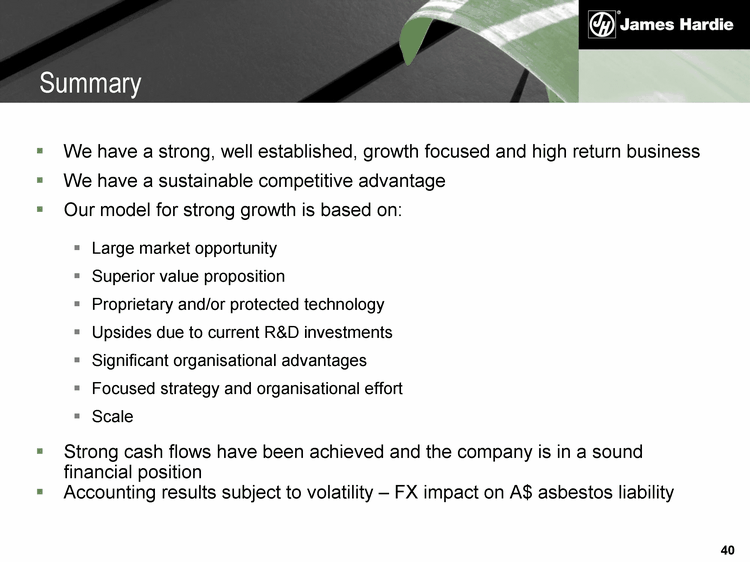
| We have a strong, well established, growth focused and high return business We have a sustainable competitive advantage Our model for strong growth is based on: Large market opportunity Superior value proposition Proprietary and/or protected technology Upsides due to current R&D investments Significant organisational advantages Focused strategy and organisational effort Scale Strong cash flows have been achieved and the company is in a sound financial position Accounting results subject to volatility - FX impact on A$ asbestos liability Summary |
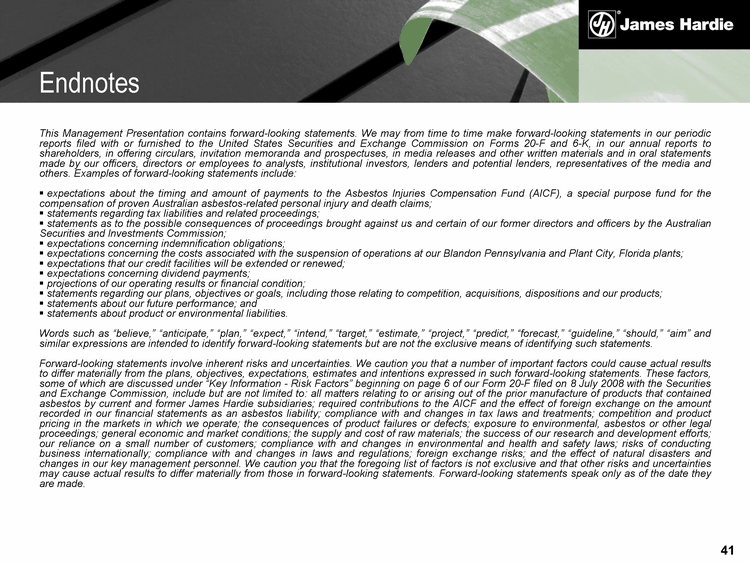
| This Management Presentation contains forward-looking statements. We may from time to time make forward-looking statements in our periodic reports filed with or furnished to the United States Securities and Exchange Commission on Forms 20-F and 6-K, in our annual reports to shareholders, in offering circulars, invitation memoranda and prospectuses, in media releases and other written materials and in oral statements made by our officers, directors or employees to analysts, institutional investors, lenders and potential lenders, representatives of the media and others. Examples of forward-looking statements include: expectations about the timing and amount of payments to the Asbestos Injuries Compensation Fund (AICF), a special purpose fund for the compensation of proven Australian asbestos-related personal injury and death claims; statements regarding tax liabilities and related proceedings; statements as to the possible consequences of proceedings brought against us and certain of our former directors and officers by the Australian Securities and Investments Commission; expectations concerning indemnification obligations; expectations concerning the costs associated with the suspension of operations at our Blandon Pennsylvania and Plant City, Florida plants; expectations that our credit facilities will be extended or renewed; expectations concerning dividend payments; projections of our operating results or financial condition; statements regarding our plans, objectives or goals, including those relating to competition, acquisitions, dispositions and our products; statements about our future performance; and statements about product or environmental liabilities. Words such as "believe," "anticipate," "plan," "expect," "intend," "target," "estimate," "project," "predict," "forecast," "guideline," "should," "aim" and similar expressions are intended to identify forward-looking statements but are not the exclusive means of identifying such statements. Forward-looking statements involve inherent risks and uncertainties. We caution you that a number of important factors could cause actual results to differ materially from the plans, objectives, expectations, estimates and intentions expressed in such forward-looking statements. These factors, some of which are discussed under "Key Information - Risk Factors" beginning on page 6 of our Form 20-F filed on 8 July 2008 with the Securities and Exchange Commission, include but are not limited to: all matters relating to or arising out of the prior manufacture of products that contained asbestos by current and former James Hardie subsidiaries; required contributions to the AICF and the effect of foreign exchange on the amount recorded in our financial statements as an asbestos liability; compliance with and changes in tax laws and treatments; competition and product pricing in the markets in which we operate; the consequences of product failures or defects; exposure to environmental, asbestos or other legal proceedings; general economic and market conditions; the supply and cost of raw materials; the success of our research and development efforts; our reliance on a small number of customers; compliance with and changes in environmental and health and safety laws; risks of conducting business internationally; compliance with and changes in laws and regulations; foreign exchange risks; and the effect of natural disasters and changes in our key management personnel. We caution you that the foregoing list of factors is not exclusive and that other risks and uncertainties may cause actual results to differ materially from those in forward-looking statements. Forward-looking statements speak only as of the date they are made. Endnotes |
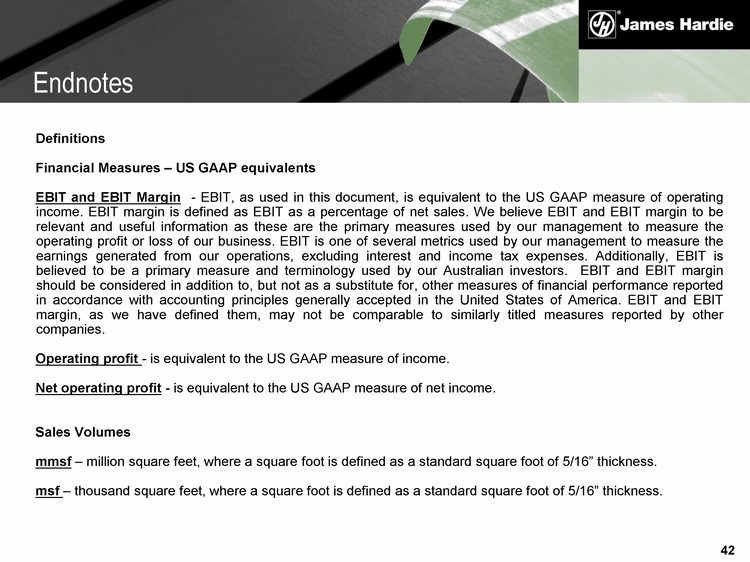
| Definitions Financial Measures - US GAAP equivalents EBIT and EBIT Margin - EBIT, as used in this document, is equivalent to the US GAAP measure of operating income. EBIT margin is defined as EBIT as a percentage of net sales. We believe EBIT and EBIT margin to be relevant and useful information as these are the primary measures used by our management to measure the operating profit or loss of our business. EBIT is one of several metrics used by our management to measure the earnings generated from our operations, excluding interest and income tax expenses. Additionally, EBIT is believed to be a primary measure and terminology used by our Australian investors. EBIT and EBIT margin should be considered in addition to, but not as a substitute for, other measures of financial performance reported in accordance with accounting principles generally accepted in the United States of America. EBIT and EBIT margin, as we have defined them, may not be comparable to similarly titled measures reported by other companies. Operating profit - is equivalent to the US GAAP measure of income. Net operating profit - is equivalent to the US GAAP measure of net income. Sales Volumes mmsf - million square feet, where a square foot is defined as a standard square foot of 5/16" thickness. msf - thousand square feet, where a square foot is defined as a standard square foot of 5/16" thickness. Endnotes |
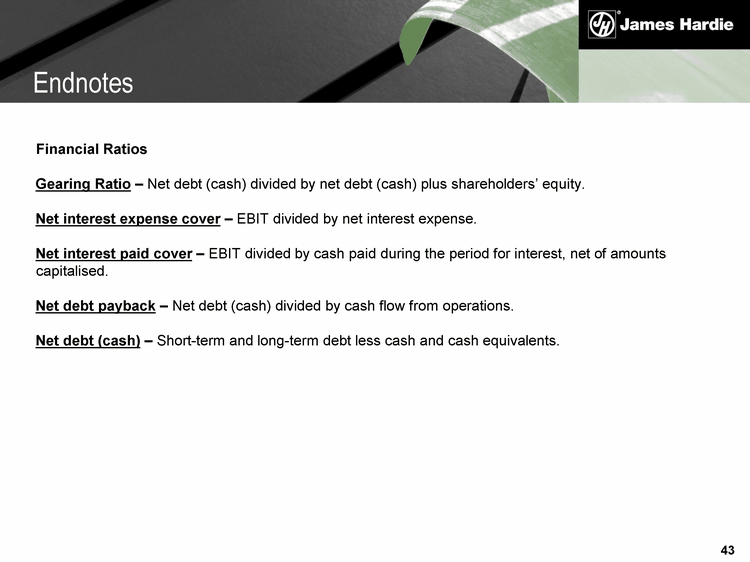
| Financial Ratios Gearing Ratio - Net debt (cash) divided by net debt (cash) plus shareholders' equity. Net interest expense cover - EBIT divided by net interest expense. Net interest paid cover - EBIT divided by cash paid during the period for interest, net of amounts capitalised. Net debt payback - Net debt (cash) divided by cash flow from operations. Net debt (cash) - Short-term and long-term debt less cash and cash equivalents. Endnotes |
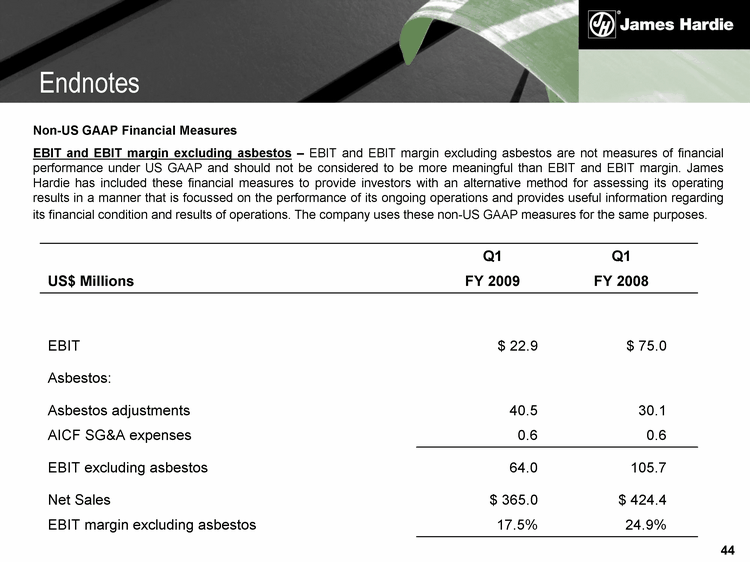
| Non-US GAAP Financial Measures EBIT and EBIT margin excluding asbestos - EBIT and EBIT margin excluding asbestos are not measures of financial performance under US GAAP and should not be considered to be more meaningful than EBIT and EBIT margin. James Hardie has included these financial measures to provide investors with an alternative method for assessing its operating results in a manner that is focussed on the performance of its ongoing operations and provides useful information regarding its financial condition and results of operations. The company uses these non-US GAAP measures for the same purposes. Q1 Q1 US$ Millions FY 2009 FY 2008 EBIT $ 22.9 $ 75.0 Asbestos: Asbestos adjustments 40.5 30.1 AICF SG&A expenses 0.6 0.6 EBIT excluding asbestos 64.0 105.7 Net Sales $ 365.0 $ 424.4 EBIT margin excluding asbestos 17.5% 24.9% Endnotes |

| Non-US GAAP Financial Measures (continued) Net operating profit excluding asbestos - Net operating profit excluding asbestos is not a measure of financial performance under US GAAP and should not be considered to be more meaningful than net income. The company has included this financial measure to provide investors with an alternative method for assessing its operating results in a manner that is focussed on the performance of its ongoing operations. The company uses this non-US GAAP measure for the same purposes. Q1 Q1 US$ Millions FY 2009 FY 2008 Net operating profit $ 1.4 $ 39.1 Asbestos: Asbestos adjustments 40.5 30.1 AICF SG&A expenses 0.6 0.6 AICF interest income (0.9) (1.6) Tax expense related to asbestos adjustments - 0.4 Net operating profit excluding asbestos $ 41.6 $ 68.6 Endnotes |
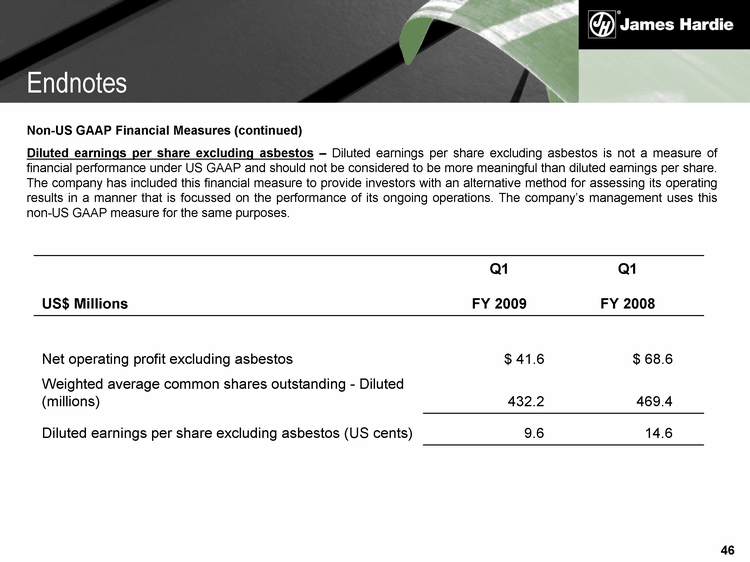
| Non-US GAAP Financial Measures (continued) Diluted earnings per share excluding asbestos - Diluted earnings per share excluding asbestos is not a measure of financial performance under US GAAP and should not be considered to be more meaningful than diluted earnings per share. The company has included this financial measure to provide investors with an alternative method for assessing its operating results in a manner that is focussed on the performance of its ongoing operations. The company's management uses this non-US GAAP measure for the same purposes. Q1 Q1 US$ Millions FY 2009 FY 2008 Net operating profit excluding asbestos $ 41.6 $ 68.6 Weighted average common shares outstanding - Diluted (millions) 432.2 469.4 Diluted earnings per share excluding asbestos (US cents) 9.6 14.6 Endnotes |
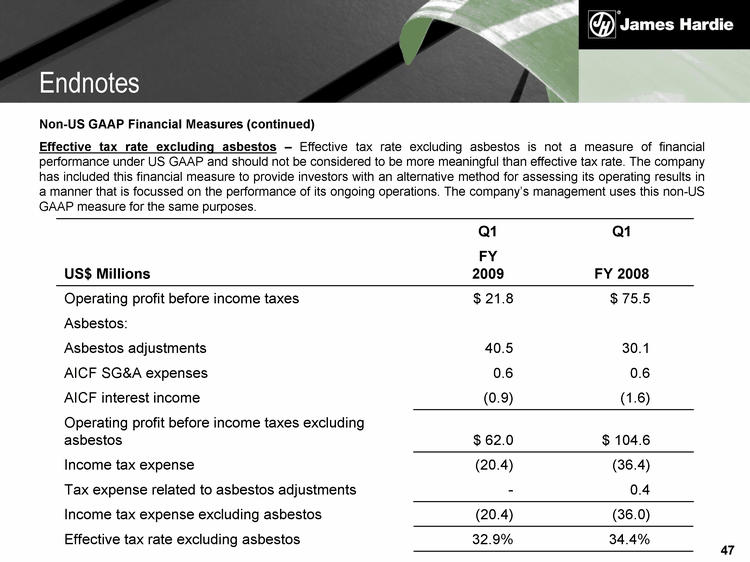
| Non-US GAAP Financial Measures (continued) Effective tax rate excluding asbestos - Effective tax rate excluding asbestos is not a measure of financial performance under US GAAP and should not be considered to be more meaningful than effective tax rate. The company has included this financial measure to provide investors with an alternative method for assessing its operating results in a manner that is focussed on the performance of its ongoing operations. The company's management uses this non-US GAAP measure for the same purposes. Q1 Q1 US$ Millions FY 2009 FY 2008 Operating profit before income taxes $ 21.8 $ 75.5 Asbestos: Asbestos adjustments 40.5 30.1 AICF SG&A expenses 0.6 0.6 AICF interest income (0.9) (1.6) Operating profit before income taxes excluding asbestos $ 62.0 $ 104.6 Income tax expense (20.4) (36.4) Tax expense related to asbestos adjustments - 0.4 Income tax expense excluding asbestos (20.4) (36.0) Effective tax rate excluding asbestos 32.9% 34.4% Endnotes |
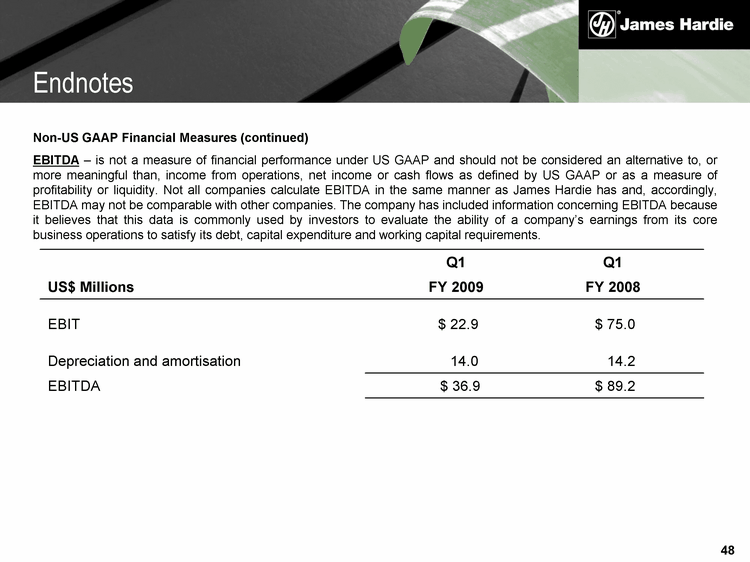
| Non-US GAAP Financial Measures (continued) EBITDA - is not a measure of financial performance under US GAAP and should not be considered an alternative to, or more meaningful than, income from operations, net income or cash flows as defined by US GAAP or as a measure of profitability or liquidity. Not all companies calculate EBITDA in the same manner as James Hardie has and, accordingly, EBITDA may not be comparable with other companies. The company has included information concerning EBITDA because it believes that this data is commonly used by investors to evaluate the ability of a company's earnings from its core business operations to satisfy its debt, capital expenditure and working capital requirements. Q1 Q1 US$ Millions FY 2009 FY 2008 EBIT $ 22.9 $ 75.0 Depreciation and amortisation 14.0 14.2 EBITDA $ 36.9 $ 89.2 Endnotes |
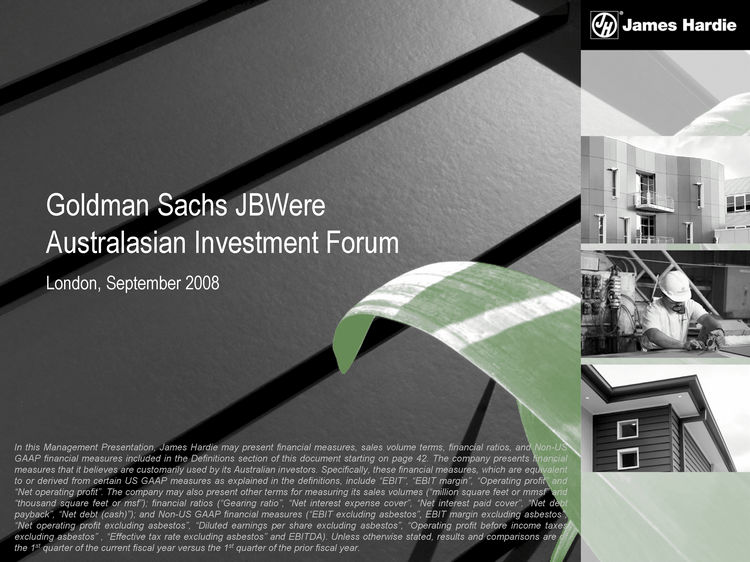
| In this Management Presentation, James Hardie may present financial measures, sales volume terms, financial ratios, and Non-US GAAP financial measures included in the Definitions section of this document starting on page 42. The company presents financial measures that it believes are customarily used by its Australian investors. Specifically, these financial measures, which are equivalent to or derived from certain US GAAP measures as explained in the definitions, include "EBIT", "EBIT margin", "Operating profit" and "Net operating profit". The company may also present other terms for measuring its sales volumes ("million square feet or mmsf" and "thousand square feet or msf"); financial ratios ("Gearing ratio", "Net interest expense cover", "Net interest paid cover", "Net debt payback", "Net debt (cash)"); and Non-US GAAP financial measures ("EBIT excluding asbestos", EBIT margin excluding asbestos", "Net operating profit excluding asbestos", "Diluted earnings per share excluding asbestos", "Operating profit before income taxes excluding asbestos" , "Effective tax rate excluding asbestos" and EBITDA). Unless otherwise stated, results and comparisons are of the 1st quarter of the current fiscal year versus the 1st quarter of the prior fiscal year. |